
Highlights of Sanuki City
Ohkushi Nature Park
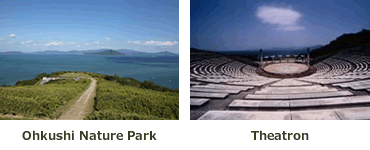 This is a leisure spot where you can enjoy the sea, the breeze, and the surrounding mountains to your heart’s content. The park features Shikoku’s first winery, the Sanuki Winery; the Sanuki City Produce Center, where you can try a sample of wine and other prefectural products; athletics fields where you can enjoy such sports as soccer; cottages; the Seaside Corridor, which also includes car camping sites. The park is always full of families and young people during the holdiays. At the furthest point of the peninsula is the Theatron, an open-air amphitheater that is designed with an ancient Greek theater motif.
This is a leisure spot where you can enjoy the sea, the breeze, and the surrounding mountains to your heart’s content. The park features Shikoku’s first winery, the Sanuki Winery; the Sanuki City Produce Center, where you can try a sample of wine and other prefectural products; athletics fields where you can enjoy such sports as soccer; cottages; the Seaside Corridor, which also includes car camping sites. The park is always full of families and young people during the holdiays. At the furthest point of the peninsula is the Theatron, an open-air amphitheater that is designed with an ancient Greek theater motif.
Tsuda no Matsubara (Prefectural Kinrin Park)
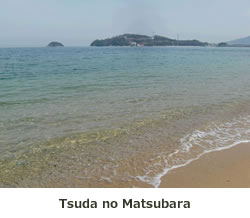 The deep blue of the sea, white sandy beaches, and brilliantly green pine trees make Kinrin Park a place of tremendous beauty. Soon after it was designated as a prefectural park, the entire Seto Inland Sea area (of which it is a part) was designated as a national park. It is said that the pine trees were first grown here since the early Edo period to serve protect the Iwashimizu Hachiman Shrine from the strong sea winds. The pine trees of the grove, which include trees aged more than 600 years and raised root pines, stretch along the beach for about one kilometer. Every year, people gather here in the summer to enjoy bathing in the sea.
The deep blue of the sea, white sandy beaches, and brilliantly green pine trees make Kinrin Park a place of tremendous beauty. Soon after it was designated as a prefectural park, the entire Seto Inland Sea area (of which it is a part) was designated as a national park. It is said that the pine trees were first grown here since the early Edo period to serve protect the Iwashimizu Hachiman Shrine from the strong sea winds. The pine trees of the grove, which include trees aged more than 600 years and raised root pines, stretch along the beach for about one kilometer. Every year, people gather here in the summer to enjoy bathing in the sea.
Okuboji Temple (Final Temple of the Shikoku 88 Temple Circuit)
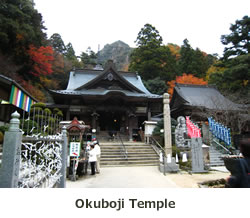 Okuboji Temple is the final temple on the Shikoku 88 Temple Pilgrimage. It is located at the base of Mt. Nyotai (elevation 776 m). The main temple sanctuary and the two-storied tahoto pagoda offer a quiet, reverent place for visitors and worshippers. Pilgrims who have successfully completed their journey to all 88 temples will leave their kongozue walking staffs as offerings at the temple. Oogoma (prayers for such things as protection from disaster, long life, usccesful match makin g, etc )are also held here. The sounds of the temple’s bell, along with the ringing of the small bells carried by individual pilgrims, were once selected by the Bureau of the Environment (which has since become the Ministry of the Environment) as one of Japan’s “100 Best Environmental Soundscapes.” Worshippers come here in great numbers every year. The temple is famous for its ginko and Japanese maple trees turning beautiful colors in the fall.
Okuboji Temple is the final temple on the Shikoku 88 Temple Pilgrimage. It is located at the base of Mt. Nyotai (elevation 776 m). The main temple sanctuary and the two-storied tahoto pagoda offer a quiet, reverent place for visitors and worshippers. Pilgrims who have successfully completed their journey to all 88 temples will leave their kongozue walking staffs as offerings at the temple. Oogoma (prayers for such things as protection from disaster, long life, usccesful match makin g, etc )are also held here. The sounds of the temple’s bell, along with the ringing of the small bells carried by individual pilgrims, were once selected by the Bureau of the Environment (which has since become the Ministry of the Environment) as one of Japan’s “100 Best Environmental Soundscapes.” Worshippers come here in great numbers every year. The temple is famous for its ginko and Japanese maple trees turning beautiful colors in the fall.
Nagaoji Temple (#87)
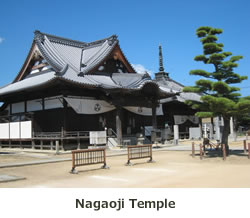 Nagaoji Temple is often called “O Kannon-san.” In front of the main gate is buried a pair of hand-copied sutras ,which are designated as Important National Cultural Properties and tell the tale of this temple, which has flourished since the Kamakura period. Also, there is a famous story in which Shizuka Gozen, following the death of her husband (the famous warrior Yoshitsune), returned here to her hometown with her mother, Iso no Zenji, so that they both could become Buddhist nuns. Memorializing this story here is a burial monument in which is said to be kept a lock of Shizuka’s hair, which was taken when she took the tonsure.
Nagaoji Temple is often called “O Kannon-san.” In front of the main gate is buried a pair of hand-copied sutras ,which are designated as Important National Cultural Properties and tell the tale of this temple, which has flourished since the Kamakura period. Also, there is a famous story in which Shizuka Gozen, following the death of her husband (the famous warrior Yoshitsune), returned here to her hometown with her mother, Iso no Zenji, so that they both could become Buddhist nuns. Memorializing this story here is a burial monument in which is said to be kept a lock of Shizuka’s hair, which was taken when she took the tonsure.
Shidoji Temple (#86)
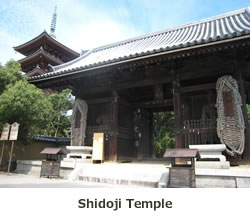 Shido Temple is a famous temple that has served as a quiet sanctuary for countless years. The main hall was built on the orders of Yorishige Matsudaira, the feudal lord of Takamatsu. There are also a cinnabar-colored 33 meter-tall five-storied pagoda and two Kongorikishi (Buddhist gods that guard a temple’s gates) that are said to be the work of the famous Buddhist sculptor, Unkei. Also, there are also a kyokusui-style garden (rare even in Japan) and the Musentei Garden, whose landscape evokes the Ama no Tamatori legend. With all of these wonderful sites, there is an endless flow of visitors to Shido Temple.
Shido Temple is a famous temple that has served as a quiet sanctuary for countless years. The main hall was built on the orders of Yorishige Matsudaira, the feudal lord of Takamatsu. There are also a cinnabar-colored 33 meter-tall five-storied pagoda and two Kongorikishi (Buddhist gods that guard a temple’s gates) that are said to be the work of the famous Buddhist sculptor, Unkei. Also, there are also a kyokusui-style garden (rare even in Japan) and the Musentei Garden, whose landscape evokes the Ama no Tamatori legend. With all of these wonderful sites, there is an endless flow of visitors to Shido Temple.
Miroku Nature Park
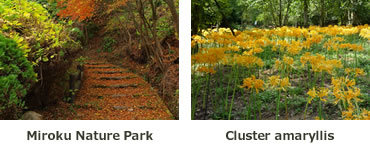 Miroku Nature Park is a place where you can get lost in the enjoyment of the beautiful nature surrounding you. It is a park facility that provides visitors with a comprehensive leisure and recreation space. It is replete with facilities, including a field athletics course, “Chibikko Land” children’s park, tennis courts, baseball fields, soccer fields, a log house bungalow, the Utopia Miroku Onsen, and more. There are also the Miroku Fureai Agricultural Park and Kabokuen Horticulture Garden for those who are interested in enjoying working with the land and with flowers and plants throughout the year!
Miroku Nature Park is a place where you can get lost in the enjoyment of the beautiful nature surrounding you. It is a park facility that provides visitors with a comprehensive leisure and recreation space. It is replete with facilities, including a field athletics course, “Chibikko Land” children’s park, tennis courts, baseball fields, soccer fields, a log house bungalow, the Utopia Miroku Onsen, and more. There are also the Miroku Fureai Agricultural Park and Kabokuen Horticulture Garden for those who are interested in enjoying working with the land and with flowers and plants throughout the year!
Monnyu no Sato
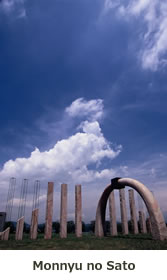 Monnyu no Sato is a place where you can interact with nature and with other people. At the entrance to Monnyu no Sato is a large field serving as a plaza, which has gone above and beyond its original design as a tree planting park and now serves in many functions as an open-air museum. It is a space that people can use as their imaginations see fit, not being limited to the constraints of traditional playgrounds and amusement facilities. The Monnyu Bridge is the symbol of this facility, at the base of which can be found the Camellia Onsen and the lawn plaza of the Mizube no Koen (Waterfront Park).
Monnyu no Sato is a place where you can interact with nature and with other people. At the entrance to Monnyu no Sato is a large field serving as a plaza, which has gone above and beyond its original design as a tree planting park and now serves in many functions as an open-air museum. It is a space that people can use as their imaginations see fit, not being limited to the constraints of traditional playgrounds and amusement facilities. The Monnyu Bridge is the symbol of this facility, at the base of which can be found the Camellia Onsen and the lawn plaza of the Mizube no Koen (Waterfront Park).